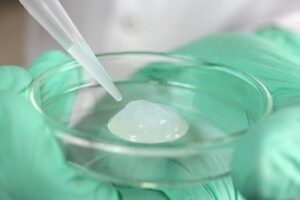3D-Printed Hydrogel: Future of Healing
The research introduces a pioneering hydrogel scaffold for tissue regeneration. This new hydrogel material is created using a unique 3D-printing technique. Combining “PTC” (printing, training, cross-linking), it produces durable, highly flexible scaffolds that help tissues heal faster and more effectively. Inspired by the layering method in Chinese ramen noodles, these hydrogels have nanoscale structures that make them incredibly strong and flexible.
The PTC method starts with 3D printing a base hydrogel scaffold. Then, it undergoes salting-out, stretching, and UV cross-linking to boost its strength. Salting-out is a process where salts are added to push water out, creating stronger molecular bonds in the hydrogel. This layering and salting-out give the hydrogel tensile strength up to 6.66 MPa, which is 622 times stronger than traditional hydrogels. This exceptional strength allows it to withstand high pressures and stretching without tearing.
Hydrogel scaffold
The scaffold’s surface has tiny patterns that promote cell growth. These patterns help cells grow in the right direction, critical for tissue repair. The high flexibility of the hydrogel means it can be customized for various tissue types, from muscle to bone. Its strength ranges from 10 kPa to 10 MPa, making it adaptable for different medical needs.
One major advantage of this hydrogel is its ability to prevent damage under stress. Traditional hydrogels tend to break or lose shape under pressure, but this scaffold is different. The salting-out and UV cross-linking processes reduce degradation, meaning it lasts longer in the body. It is also biocompatible and non-toxic, which is essential for safe medical use.
The study showed that this scaffold supports new tissue growth within four weeks. It promoted the development of muscle fibers, blood vessels, and nerves in lab tests, showing its potential for real-world applications. This innovation could revolutionize tissue engineering by offering a durable, flexible solution for healing damaged tissues.
These findings show that PTC hydrogel scaffolds are effective, resilient, and adaptable. Their potential spans various applications, from soft tissue repair to muscle regeneration. By combining strength, flexibility, and biocompatibility, this hydrogel offers an advanced approach to tissue repair. It opens possibilities for improved patient outcomes and faster recovery.
Read more about this research here





